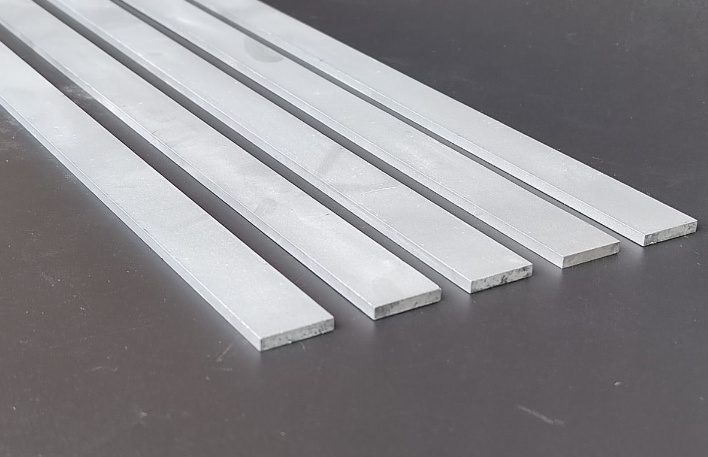카바이드 스트립은 눈에 잘 띄지 않는 초경질 소재 조각으로, 수많은 산업 공정의 숨은 일꾼입니다. 헤드라인을 장식하지는 않지만 절단, 성형 및 극한 조건을 견디는 능력으로 인해 놀랍도록 다양한 응용 분야에서 없어서는 안 될 필수 요소입니다. 카바이드 스트립의 세계로 들어가 그 비밀을 밝히고 주요 용도를 살펴보는 여정에 함께하세요.
카바이드 스트립이란 정확히 무엇인가요?
다이아몬드의 강도에 필적할 정도로 단단한 소재를 상상해 보세요. 이것이 바로 카바이드 스트립의 본질입니다. 이 얇고 납작한 조각은 뛰어난 경도와 내마모성으로 유명한 복합 소재인 초경합금으로 제작됩니다. 마법은 그 구성에 있습니다:
- 텅스텐 카바이드: 다이아몬드만큼이나 단단한 경도로 유명한 슈퍼스타 성분이 소재의 중추를 형성합니다.
- 코발트 바인더: 접착제처럼 작용하는 코발트는 텅스텐 카바이드 입자를 서로 결합하여 강도와 인성을 제공합니다.

챔피언 만들기: 카바이드 스트립이 탄생하는 과정
카바이드 스트립의 탄생은 정밀 엔지니어링의 증거입니다:
- 파우더 파워: 텅스텐 카바이드와 코발트를 미세하게 분쇄한 분말을 정확한 비율로 세심하게 혼합하여 원하는 특성을 얻습니다.
- 압박감 속에서: 그런 다음 파우더 혼합물을 특수 금형 내에서 엄청난 압력을 가하여 스트립의 초기 모양을 만듭니다.
- Fiery Fusion: 압착된 스트립은 통제된 분위기에서 고온 소결 공정을 거칩니다. 이 강렬한 열이 코발트 바인더를 융합하여 스트립을 밀도가 높고 매우 단단한 재료로 응고시킵니다.
- 완벽한 연마: 소결 후 스트립은 연마, 연마 또는 코팅과 같은 추가 가공을 거쳐 표면 마감과 치수를 개선하고 특정 특성을 향상시킬 수 있습니다.
모든 필요에 맞는 스트립: 유형 및 속성
카바이드 스트립은 획일적인 제품이 아닙니다. 다양한 등급, 크기, 구성으로 제공되며 각각 특정 용도에 맞게 맞춤화되어 있습니다. 여기에서 그 다양성을 엿볼 수 있습니다:
카바이드 스트립 속성: 스냅샷
| 속성 | 설명 | 일반적인 값 |
|---|---|---|
| 경도(HRA) | 긁힘 및 들여쓰기에 대한 내성 | 88-95 |
| 가로 파열 강도(TRS) | 파손 없이 굽힘 힘을 견디는 능력 | 1500-3000 N/mm² |
| 밀도 | 단위 부피당 질량 | 13.5-15.0 g/cm³ |
| 입자 크기 | 경도 및 내마모성에 영향을 미치는 텅스텐 카바이드 입자의 크기 | 0.5-10 µm |
| 코발트 콘텐츠 | 인성 및 내마모성에 영향을 미치는 코발트 바인더의 비율 | 6-12% |
표 1: 카바이드 스트립의 주요 속성
카바이드 스트립의 주요 응용 분야
카바이드 스트립의 뛰어난 특성 덕분에 내구성, 정밀도, 수명이 가장 중요한 까다로운 애플리케이션에 이상적입니다. 카바이드 스트립의 주요 영역을 살펴보겠습니다:
1. 목공: 목재 길들이기
- 톱 팁: 카바이드 스트립은 원형 톱날, 연귀 톱날, 테이블 톱날의 절삭 날을 형성하여 경재, 합판, 복합재 등을 깨끗하고 정밀하게 절단할 수 있습니다.
- 라우터 비트: 라우터 비트의 초경 인서트는 목공 프로젝트의 성형, 프로파일링 및 목공 작업에 날카롭고 오래 지속되는 절삭 날을 제공합니다.
2. 금속 가공: 정교한 강철 성형
- 절단 도구: 초경 인서트는 선반 공구, 밀링 커터 및 기타 금속 절삭 공구의 핵심 부품으로, 다양한 금속을 높은 정밀도와 효율로 가공할 수 있게 해줍니다.
- 부품 착용: 카바이드 스트립은 금속 성형 금형, 펀치 및 기타 툴링에서 내마모성 부품을 만드는 데 사용되어 수명을 연장하고 치수 정확도를 유지합니다.
3. 건설: 콘크리트 정복과 그 너머
- 콘크리트 톱질: 카바이드 스트립 조각은 콘크리트 톱날의 절삭 톱니를 형성하여 콘크리트, 아스팔트 및 기타 단단한 건축 자재를 절단할 수 있습니다.
- 드릴링 및 보링: 초경 인서트는 콘크리트, 암석 및 기타 까다로운 재료를 관통하기 위한 드릴 비트, 코어 비트 및 기타 드릴링 도구에 사용됩니다.
4. 기타 산업: 지평의 확장
카바이드 스트립의 응용 분야는 이러한 1차 산업을 훨씬 뛰어넘습니다. 카바이드 스트립의 고유한 특성은 다음과 같은 분야에서 가치를 발휘합니다:
- 제조: 다양한 제조 공정을 위한 내마모성 가이드, 툴링 구성 요소 및 절삭 날을 제공합니다.
- 농업: 경작 도구, 농기계용 마모 부품, 농작물 가공용 부품.
- 인쇄 및 포장: 인쇄기 및 포장 장비의 절단날, 주름 규칙 및 기타 내마모성 부품.
자주 묻는 질문: 카바이드 스트립의 미스터리 풀기
1. 카바이드 스트립이 왜 그렇게 단단한가요?
카바이드 스트립의 극한의 경도는 주로 구조 내의 텅스텐 카바이드 입자에서 비롯됩니다. 텅스텐 카바이드는 다이아몬드 다음으로 알려진 가장 단단한 재료 중 하나입니다.
2. 카바이드 스트립을 연마할 수 있나요?
예, 카바이드 스트립은 특수 다이아몬드 연삭 휠과 장비를 사용하여 연마할 수 있습니다. 그러나 최적의 성능을 위해서는 연마하는 동안 올바른 각도와 간격을 유지하는 것이 중요합니다.
3. 절삭 공구에 카바이드 스트립을 사용하면 어떤 이점이 있나요?
카바이드 스트립은 절삭 공구에서 다음과 같은 여러 가지 이점을 제공합니다:
– 경도 및 내마모성 향상: 공구 수명을 연장하고 샤프닝을 위한 가동 중단 시간을 줄일 수 있습니다.
– 더 빠른 커팅 속도와 피드: 자재 제거 속도가 빨라지고 생산성이 향상됩니다.
– 향상된 컷 품질: 조각이나 찢어짐이 적고 더 깨끗하고 정밀한 커팅이 가능합니다.
4. 카바이드 스트립으로 작업할 때 안전상의 문제가 있나요?
카바이드 스트립은 경도가 매우 높기 때문에 떨어뜨리거나 잘못 취급하면 부서질 수 있습니다. 카바이드 스트립을 다룰 때는 항상 보안경, 장갑, 적절한 복장을 착용하세요.
5. 특정 용도에 적합한 카바이드 스트립을 선택하려면 어떻게 해야 하나요?
적절한 카바이드 스트립을 선택하려면 다음과 같은 요소를 고려해야 합니다:
– 자르는 재료: 다양한 카바이드 재종은 특정 재료(예: 목재, 금속, 콘크리트)를 절단하는 데 최적화되어 있습니다.
– 절단 조건: 절삭 속도, 이송 속도 및 절삭 깊이는 카바이드 재종 및 형상 선택에 영향을 미칩니다.
– 원하는 도구 수명: 공구 수명이 길어야 하는 응용 분야에서는 고급 카바이드 스트립을 사용하면 이점을 얻을 수 있습니다.
카바이드 공급업체 또는 툴링 전문가와 상담하면 필요에 맞는 최적의 카바이드 스트립을 선택하는 데 유용한 지침을 얻을 수 있습니다.
카바이드 스트립을 좋은 가격에 구매하고 싶으신가요? 클릭하세요 여기.




